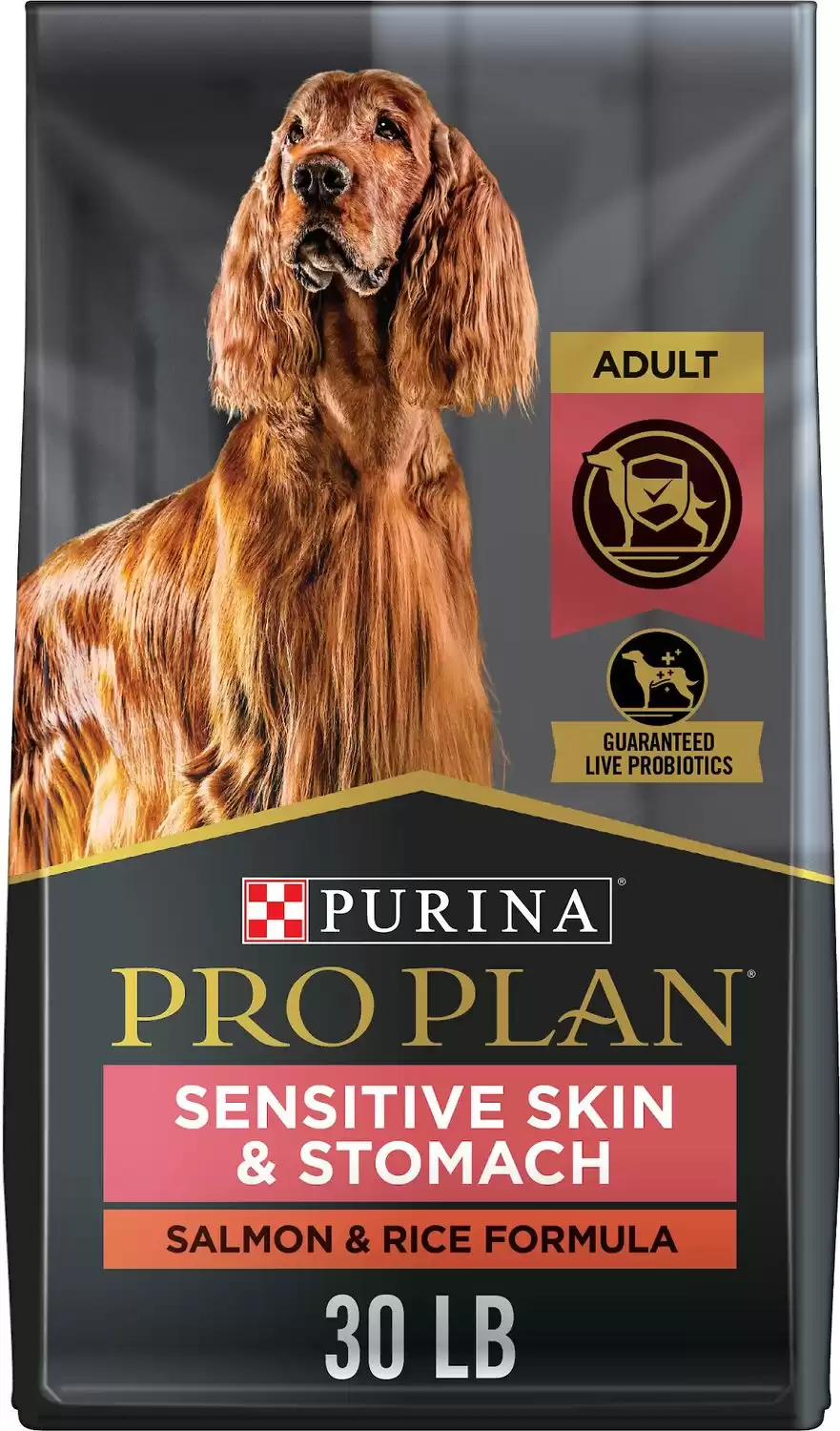Siberian Retriever
Canis lupus
Many husky Labs have one blue eye and one brown eye.
Advertisement
Siberian Retriever Scientific Classification
- Kingdom
- Animalia
- Phylum
- Chordata
- Class
- Mammalia
- Order
- Carnivora
- Family
- Canidae
- Genus
- Canis
- Scientific Name
- Canis lupus
Read our Complete Guide to Classification of Animals.
Siberian Retriever Conservation Status
Siberian Retriever Facts
- Fun Fact
- Many husky Labs have one blue eye and one brown eye.
- Temperament
- Intelligent and affectionate but can be stubborn
- Diet
- Omnivore
Siberian Retriever as a Pet:
- General Health
- Energy Level
- Shedability
- Trainability
- Intelligence
- Tendency to Chew
- Size
- Family and kid friendliness
- Yappiness / Barking
- High
- Separation Anxiety
- High
- Preferred Temperature
- Cold climate
- Exercise Needs
- High
- Friendly With Other Dogs
- Moderate
- Pure bred cost to own
- $500 to $2,000
- Dog group
- Non-sporting
- Male weight
- 45-65 lbs
- Female weight
- 40-60 lbs
This post may contain affiliate links to our partners like Chewy, Amazon, and others. Purchasing through these helps us further the A-Z Animals mission to educate about the world's species.
View all of the Siberian Retriever images!
Many a Siberian retriever has one blue eye and one brown eye.
Siberian Retrievers are an attractive hybrid mix that has been bred by crossing a Labrador retriever with a Siberian husky. Both parent lines are medium to large working dogs, but their temperaments are very different: Labs are known for their friendly, almost goofy personalities while huskies are loyal but stubborn. Since even if they come from the same litter, no two Siberian retrievers are ever quite alike, you can never predict what your Siberian retriever’s appearance or temperament will be like in advance. One thing’s for certain, though: Your pet will be very intelligent, so the sooner training begins, the better.
See all of our expert product reviews.
Other names for the Siberian retriever include husky Lab, Labsky, Labradorksy, and Huskador. This crossbreed should not be confused with the Goberian or Gusky, which is a cross between the Siberian husky and the Golden retriever. Siberian retriever coats can be one of any number of colors, including black, white, chocolate, brown, or tan. Huskadors with chocolate coloring is always offspring of the unique chocolate Labrador retriever. Siberian retrievers may inherit webbed feet from their Labrador parent. This crossbreed is recognized by the Dog Registry of America.
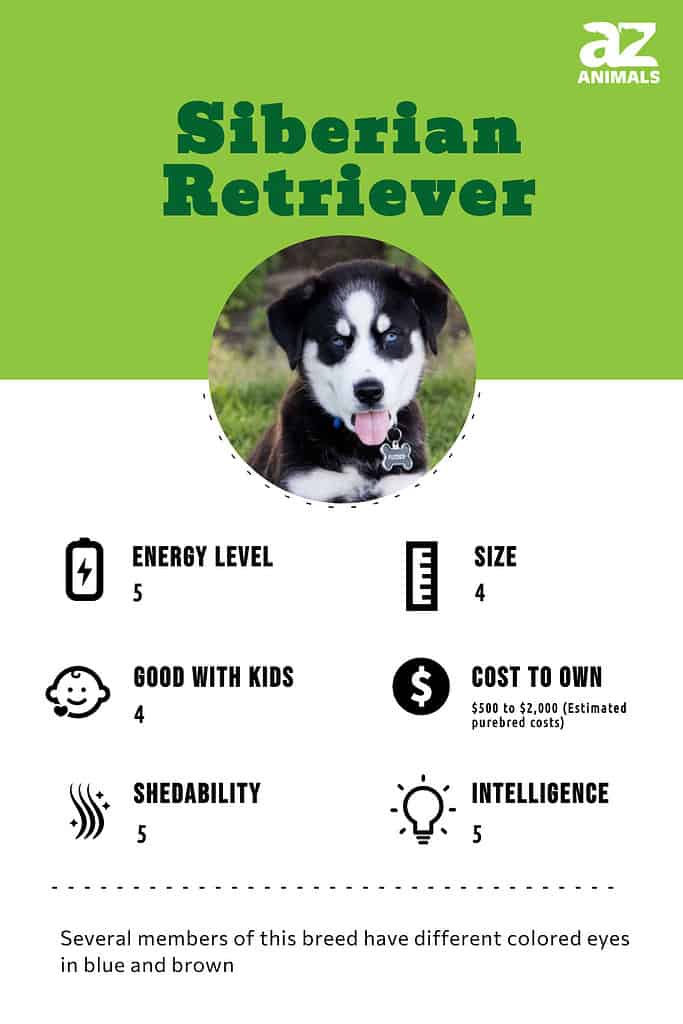
3 pros and cons of owning Siberian Retrievers
| Pros! | Cons! |
|---|---|
| They’re intelligent: Both the husky Lab’s parents are working dogs, and working dogs are extremely smart. They learn easily and retain training after as few as five repetitions, which makes them great service animals and eager participants in canine sports such as agility and freestyle frisbee. | They shed: Shedding is a real issue with these hybrids, particularly if your dog has inherited the Siberian husky’s thicker double coat. Shedding takes place throughout the year but is most noticeable with the onset of warmer weather. |
| They’re loyal: Siberian retrievers have no trouble at all bonding with their human families. This hybrid mix’s intense loyalty is inherited from its husky forebearers. | They need exercise: Siberian Retrievers are very active dogs. Be prepared to exercise your husky Lab for at least 60 minutes a day. When we write “exercise,” we’re not talking about a slow shuffle around the block but hiking or long-distance jogs. They also love to swim. |
| They’re protective: Husky Labs make great watchdogs because they’re very protective of their families. This can sometimes be a mixed blessing, though, since they can be aloof or even downright hostile to strangers and other dogs. | They need space: Siberian retrievers do not do well in close quarters. They need a house, preferably with a large yard. |
Size and Weight
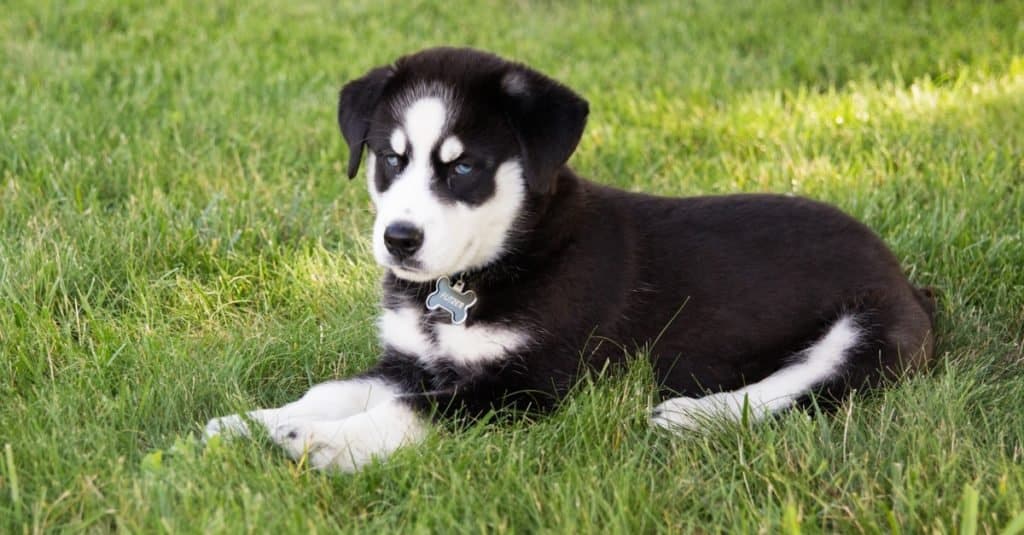
©Anastasia Musikhina/Shutterstock.com
Any individual Siberian retriever’s dimensions will depend upon which of its parents it most resembles. Male dogs are slightly larger than female dogs. At six months old, puppies will be around 13 inches tall and weigh about 25 pounds; at one year, puppies will be 20 inches tall and weigh 40 pounds.
The typical height range for a full-grown male is 21 to 25 inches while the full-grown females range is 20 to 24 inches. These crossbreeds weigh between 40 and 60 pounds.
| Height (Male) | 25’’ Tall |
| Height (Female) | 22” Tall |
| Weight (male) | 45-60 lbs., fully grown |
| Weight (female) | 40-55 lbs., fully grown |
Origins

The Siberian Husky is one of the ancestors of the Siberian Retriever
Health and Entertainment for your Siberian Retriever
See all of our expert product reviews.
©Sbolotova/Shutterstock.com
In order to ascertain the origins of this hybrid breed, it is necessary to take a peek at those of the two breeds it comes from:
The Labrador retriever itself is actually the result of crossbreeding between hunting dogs native to the British Isles with St. John’s water dogs in the 1800s.
The Siberian husky itself is a canine of the Spitz variety with origins which can be traced back to 10 centuries and is relieved to actually possess wolf ancestry.
The Siberian retriever itself is a comparatively recent breed considered to be a designer breed which emerged in the 1990s when canine enthusiasts bred both Labrador retrievers with Siberian huskies.
Common Health Issues
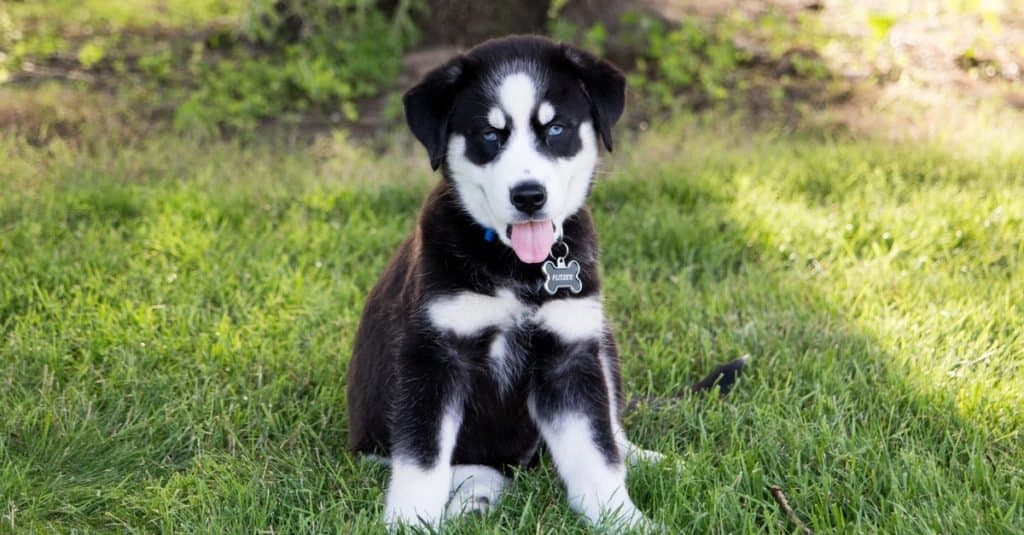
Siberian Retrievers are healthy but are prone to bloat and ear infections
©Anastasia Musikhina/Shutterstock.com
Labrador retrievers and Siberian huskies are healthy breeds for the most part that isn’t excessively inbred, so their hybrid offspring tend to be healthy, too. Their typical lifespan ranges between 10 and 14 years. Still, it’s wise to make sure any breeder you deal with has tested the puppy you’re interested in adopting to rule out the possibility of congenital health conditions.
Hip dysplasia can become a concern, particularly if your husky Lab is overweight or isn’t getting enough exercise. Because of their size and large appetites, Siberian retrievers can also be affected by bloat, which can make it difficult for them to breathe properly. They may be predisposed to ocular conditions like cataracts, progressive retinal atrophy, and corneal dystrophy. Finally, because of the shape of their ears, they’re prone to ear infections, especially if they spend a lot of time outside and dust, dirt, or other debris gets into their ears.
- Hip dysplasia
- Bloat
- Ocular conditions
- Ear infections
Temperament
Siberian retrievers have lively and affectionate personalities. This is not a dog you can leave alone for long periods of time; if you do, your pet is likely to develop separation anxiety that is so intense that he or she will begin manifesting destructive behaviors. Another distinctive Siberian retriever trait is their hunting instincts, inherited from their Siberian husky parent. Early socialization is a must if you don’t want your Huskador to behave aggressively toward other animals.
How To Take Care of a Siberian Retriever
Siberian retrievers put on weight quickly if you overfeed them, so special attention must be paid to their dietary needs. Other factors you’ll need to consider as a pet parent to this crossbreed include their unique needs for activity, training, and grooming.
The Best Dog Food for Siberian Retrievers
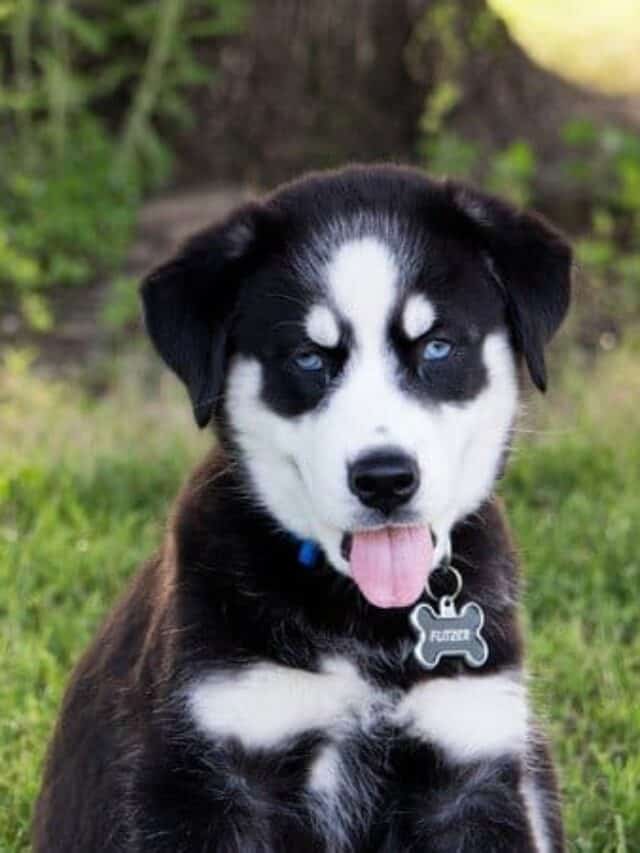
Siberian Retrievers require high quality food which is high in protein
©Anastasia Musikhina/Shutterstock.com
A full-grown husky lab will need 1,000 to 1,500 calories or two and a half to three cups of high-quality dog food per day. If your dog is particularly active, he or she may need more than that. Because of this hybrid breed’s tendency to develop bloat, wet dog food is not recommended. Look for brands that contain at least 25 percent protein, 10 percent fat, and a healthy amount of fiber, but avoid fillers like corn, soybeans, or wheat.
We know this breed sheds quite a bit. And while this doesn’t replace grooming or eliminate the hassle of this breed’s mountain of fur, there are shed-control dog foods out there to consider.
Huskador puppies will need a specially formulated puppy kibble until they’re one year of age. Puppies should be fed three to four times a day until they’re six months old. Older puppies and adult Siberian retriever dogs should be fed at least twice a day to help them control their tendency toward bloat.
A-Z Animals prefers Purina Pro Plan Sensitive Skin & Stomach, High Protein Dry Dog Food as the best dog food for Siberian Retrievers.
This salmon kibble has natural glucosamine from fish to help stave off conditions like hip dysplasia. It simultaneously addresses this breed’s digestion and immune system via probiotics that balance the gut biome.
See if your dog thrives eating Purina Pro Plan Sensitive Skin and Stomach High protein dog food, available on Chewy or Amazon.
- Salmon and rice recipe for sensitive stomachs and and skin
- Live probiotics for optimum digestive health
- Sunflower oil promotes healthy skin and coat
Maintenance And Grooming
If you have allergies, a Siberian retriever is not the ideal dog for you. Shedding is a big issue. You’ll need to brush them once a day with a pin brush to eliminate dead hair, and even with that, expect power vacuuming to become a regular part of your house cleaning routine. On the plus side, though, they don’t develop that distinctive dirty doggie smell that some canines develop if they go without a bath for more than a week. You won’t have to bathe your dog more often than once a month unless she or he has been playing in the dirt outside.
As noted above, this hybrid mix has a tendency to develop ear infections, particularly if he or she has inherited floppy retriever ears. Get your vet to show you how to clean ears safely. Your dog’s teeth should be brushed at least three times a week, and his or her nails will need to be clipped on a monthly basis.
Training
Siberian Retrievers are very smart, which should make them easy to train, right? For the most part, this is true, but if your pet has inherited the husky stubbornness trait, you will first have to convince him or her that you are the alpha in the pack. For this reason, it’s important to start training and socializing your Siberian retriever as soon as you introduce him or her into your household. Great patience is required because these dogs can be very independent thinkers. This is why Siberian retrievers may not be great pets for first-time dog owners.
Once your dog gets into the rhythm, though, the sky’s the limit in terms of how much they can learn. These dogs do not respond well to negative reinforcement. Be firm and assertive, but praise lavishly and bestow treats when your dog gets it right, and you’ll be amazed at how quickly members of this breed will learn to follow your commands.
Exercise

Siberian Retrievers are active and especially fond of digging and running
©Anastasia Musikhina/Shutterstock.com
Siberian Retrievers crave exercise. These dogs are rovers; if you don’t exercise them, they will simply slip out an open door and exercise themselves. They love to run, and they also love to dig. Rather than try and curb their digging behavior, it’s probably best to designate one area of your backyard as their digging area and train them to constrain their digging to that spot. Other physically demanding exercises that this hybrid mix enjoys include swimming, playing ball, playing frisbee, running as you bike, and even pulling wagons and kiddie carts.
Puppies
Siberian Retrievers are almost always first-generation hybrids. That means that puppies are almost always the offspring of a purebred Labrador retriever and a purebred Siberian husky. Since Labradors are slightly larger than huskies, on the whole, Labrador females almost always bear the pups. Puppies are considered full-grown at around 18 months of age.
Children
If they’ve been well trained and socialized, Siberian Retrievers are very good with children, even toddlers. They will be good-humored even when their ears and tails are being pulled. However, it’s never a good idea to leave children under 10 and large dogs unchaperoned together.
Dogs similar to Siberian retrievers

Malamutes which are similar to Siberian retrievers make up for their comparative lack of speed with impressive levels of strength and endurance
©Aneta Jungerova/Shutterstock.com
Malamutes, golden retrievers and Samoyeds share some similarities with Siberian retrievers.
- Malamutes: Like the Siberian retriever’s husky forbearer, malamutes were bred to pull sleds. Weighing close to 100 pounds, however, malamutes are much bigger than Siberian retrievers. Malamutes can be black, tan, or sable, but white is the predominant color of their faces and underbody.
- Golden retrievers: Golden retrievers are also larger than Siberian retrievers, but they share the same sweet, affectionate nature. Goldens’ characteristic lustrous, light-colored coats give them a very distinctive appearance.
- Samoyeds: Samoyeds were also originally bred to pull sleds in Siberia. Samoyeds are spitz dogs, meaning they are closely related to wolves. For the most part, they are pure white dogs with fluffy coats, slightly smaller than Siberian retrievers, but a few have biscuit-colored (tan) coats. They are never black.
Popular Names for Siberian retrievers
Have a look at these popular names for your dog:
- Chinook
- Sidra
- Nanuk
- Ghost
- Anastasia
Siberian Retriever FAQs (Frequently Asked Questions)
How much does a Siberian retriever cost to own?
Depending on its parents’ lineage, a Siberian retriever puppy can have a price tag that’s anywhere between $500 to $2,000. Other one-time adoption costs will include spaying, vaccinations, microchipping, and training as well as the purchase of bedding, leashes, bowls, crates, and toys. The price for these can range anywhere from $1,000 to $1,500.
Thereafter you can expect to spend $1,500 a year on food, vet bills, and incidental expenses for your Siberian retriever.
Are Siberian retrievers good with kids?
A properly trained and socialized Siberian retriever will be very good with kids.
How long do Siberian retrievers live?
Siberian retrievers live between 10 and 14 years.
Are Siberian retrievers hypoallergenic?
Siberian Retrievers are not hypoallergenic. Shedding is a major challenge with these canines.
Are husky Labs aggressive?
A husky Lab that has not been properly socialized and trained can be aggressive.
Do lab husky mixes shed?
Lab husky mixes are big shedders.
How much is a Siberian husky golden retriever mix?
Prices for a Siberian husky/golden retriever puppy range between $250 and $1,500.
How do you train a Siberian retriever?
Siberian Retrievers respond best to training that emphasizes positive reinforcement.
Thank you for reading! Have some feedback for us? Contact the AZ Animals editorial team.
Sources
- Paw Castle, Available here: https://pawcastle.com/siberian-retriever/
- Dog’s Best Life, Available here: https://dogsbestlife.com/dog-breeds/labsky/
- Wag, Available here: https://wagwalking.com/breed/siberian-retriever#
- Pet Side, Available here: https://www.petside.com/husky-lab-mix/
- Doggie Designer, Available here: https://doggiedesigner.com/siberian-retriever/
- The Labrador Site, Available here: https://www.thelabradorsite.com/husky-lab-mix/#proscons
- Labrador Training HQ, Available here: https://www.labradortraininghq.com/labrador-breed-information/husky-lab-mix/
- Animals So, Available here: https://animalso.com/breeds/golden-retriever-husky-mix/





